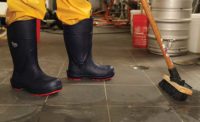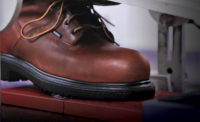ASTM F2913-11 for slip performance evaluation- footwear/surfaces

Scope
This test method determines the dynamic coefficient of friction between footwear and floorings under reproducible laboratory conditions for evaluating relative slip performance. The method is applicable to all types of footwear, outsole units, heel top-pieces (top-lifts) and sheet soling materials, also to most types of indoor floorings, including matting and stair nosing, and surface contaminants on the flooring surface, including but not limited to liquid water, ice, oil and grease. The method may also be applied to surfaces such as block pavers, turf and gravel.
Special purpose footwear or fittings containing spikes, metal studs or similar may be tested on appropriate surfaces but the method does not fully take account of the risk of tripping due to footwear/ground interlock.
The values stated in the ASTM test method in metrics are to be regarded as the standard. The values in parentheses are for information.
This standard does not purport to address all of the safety concerns, if any, associated with its use. It is the responsibility of the user of this standard to establish appropriate safety and health practices and determine the applicability of regulatory limitations prior to use.
Why this standard is important
Slip resistance testing is a complex process, and an effective slip test machine needs to control and measure a number of key criteria reproducing the critical factors relating to slip when walking. ASTM F2913-11 provides a quantitative assessment of the safety of footwear for the U.S. market.
This is the latest standard test method to determine dynamic coefficients of friction, which extends to producing slip-resistant footwear.
Many factors affect slips, trips, and falls, prompting manufacturers is to assess the coefficient of friction (COF) for footwear under laboratory settings for several different conditions.
In a recent survey, 46 percent of respondents said there are only 0-3 same-level fall risk areas in their facility. Yet, the survey revealed more than 10 different locations identified as common fall locations. There is a serious and risky disconnect between perceptions and the true scope of same-level slips and falls risks.
The survey shows that many organizations underestimate same-level slip and fall risks. They are ignorant of high-risk walk zones within their facilities. This exposes them to significant liability, medical costs, productivity losses and damage to brand reputation.
Most respondents (54 percent) were not aware of the final OSHA Walking-Working Surfaces rule, which took effect in January of 2017, providing employee safety standards for a wide range of workplaces. Only 29 percent reported meeting the rule’s requirements.
Hazards
According to the U.S. Bureau of Labor Statistics, same-level slip and fall accidents are the leading cause of workplace injuries, totaling nearly 200,000 in 2015. And the 2017 Liberty Mutual Workplace Safety Index reports that these types of falls resulted in almost $11 billion in workers’ compensation and medical costs last year.
OSHA states that slips, trips, and falls constitute the majority of general industry accidents. They cause 15 percent of all accidental deaths, and are second to motor vehicle accidents as a cause of fatalities.
Key requirements
Purchase ASTM F2913-11A at www.astm.org. ASTM F2913-11A provides a defined, reproducible test method to assess the dynamic coefficient of friction for the whole shoe under various conditions and in modes simulating a walking gait. F2913-11 testing involves three modes to determine the dynamic COF in three specific areas of a simulated walking gait. The three modes are:
- Forward Heel Slip: Assess the COF at the critical “heal strike” of the gait
- Forward Flat Slip: Assess the COF at the midstance of the gait
- Backward Slip on the Forepart: Assesses the COF at the “toe off” of the gait
Keywords
A coefficient of friction is not technically the same as slip resistance, although the terms are frequently used interchangeably. Slip resistance is defined in ASTM F1646 as “the relative force that resists the tendency of the shoe or foot to slide along the walkway surface.” A COF, on the other hand, is the ratio of the frictional force between two bodies and the force pressing them together.
A COF can be calculated under controlled laboratory conditions. Slip resistance involves a complex interplay of factors including the walkway surface conditions and pitch, the footwear tread pattern, the walking gait of the individual, and the presence of foreign materials on the floor surface, to name a few. The focus on coefficients of friction to assess slip resistance stems from the fact that the COF and the force required to slide an object are directly proportional — the greater the COF the greater the resistance to sliding.
The ASTM standard is not only applicable to assessing footwear slip resistance, but is also intended (as defined within the scope of the standard), to allow the assessment of “most types of indoor floorings, including matting and stair nosing, and surface contaminates on the flooring surface, including – but not limited to – liquid water, ice, oil and grease.” The scope also makes reference to surfaces “such as block pavers, pavers, turf and gravel,” as well as “special-purpose footwear or fittings containing spikes, metal studs or similar,” which “may be tested on appropriate surfaces.”
A slip test machine can be used as a development tool to verify the slip resistance of new footwear products. It can also validate these products against a footwear specification in which a required coefficient of friction has been specified. Testing against industry-accepted slip resistance standards is a proven method to validate products, and to demonstrate due diligence in assessing products’ slip resistance.
The output from the test is a determination of the coefficient of friction between the shoe and the test surface. The coefficient of friction is defined as the ratio of the horizontal force to the vertical force as the shoe slips. A low coefficient of friction indicates that only a low horizontal load would be needed to cause the shoe to slip against the flooring type used in the test. By using a standard test surface, and with reference to acceptable required minimum and maximum coefficients of friction, the footwear can be assessed for slip resistance. In addition to the coefficient of friction result, the loads, speeds, horizontal distance covered and a continuous calculation of coefficient of friction are recorded graphically for the duration of the test.
History
In 2011 the ASTM published F2913-11, Standard Test Method for Measuring the Coefficient of Friction for Evaluation of Slip Performance of Footwear and Test Surfaces/Flooring Using a Whole Shoe Tester. ASTM F2913-11 determines the dynamic COF between footwear and floor contaminants under reproducible laboratory conditions. It is applicable to all types of footwear, to most types of indoor floorings, and it allows testing of various flooring surface contaminants.
Referenced documents
- ASTM F1646 Terminology Relating to Walkway Safety and Footwear
- ASTM F2508 Practice for Validation, Calibration, and Certification of Walkway Tribometers Using Reference Surfaces
Sponsor: www.tingleyrubber.com 800-631-5498
Looking for a reprint of this article?
From high-res PDFs to custom plaques, order your copy today!




